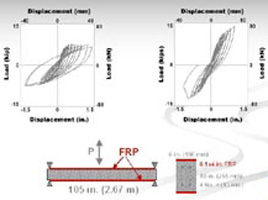Tilt-Up Walls Seismic Repair and Strengthening of Tilt-up Walls with Glass or Carbon FRP
Glass or Carbon FRP offer ideal solutions for seismic repair or strengthening of tilt up walls. Glass FRP (GFRP) and Carbon FRP (CFRP) can also be used for strengthening walls around door or window openings to create lintels or piers that are reinforced with FRP. Many existing and older tilt up walls are inadequately reinforced, resulting in cracking of the wall panels under severe loads such as an earthquake. Tilt up walls can be strengthened with Glass or Carbon Fiber Reinforced Polymer (FRP). In some cases, fire damage could lead to weakened wall panels that may require strengthening; such fire-damaged walls could also be strengthened with Glass FRP (GFRP) or Carbon FRP (CFRP).
Crack Injection vs. Strengthening with FRP
Flexural Behavior
Cyclic Test of R/C Elements The flexural strength of tilt-up wall panels is enhanced in accordance with the same principles discussed for concrete beams and URM walls. Our tests for two wall panels are shown on the right. The panels were subjected to out-of-plane cyclic loading similar to that experienced during an earthquake. The hysteretic response shown on the left is for the control specimen. The graph on the right is for a similar specimen that was strengthened by applying a layer of glass FRP on each face. Clearly, the strength of the retrofitted specimen is significantly improved and it shows very good hysteretic behavior. |
 |
Shear Behavior
The shear strength of tilt-up wall panels is enhanced in accordance with the same principles discussed for concrete beams and URM walls.
A more detailed description of the benefits of this strengthening approach and details of a filed application are presented in a paper that appeared in Earthquake Spectra.
Case Studies
Several tilt-up buildings have been strengthened using QuakeWrap™ glass FRP products. A sample of projects are listed below. By clicking on each project, you will be able to view specific information on each project.


